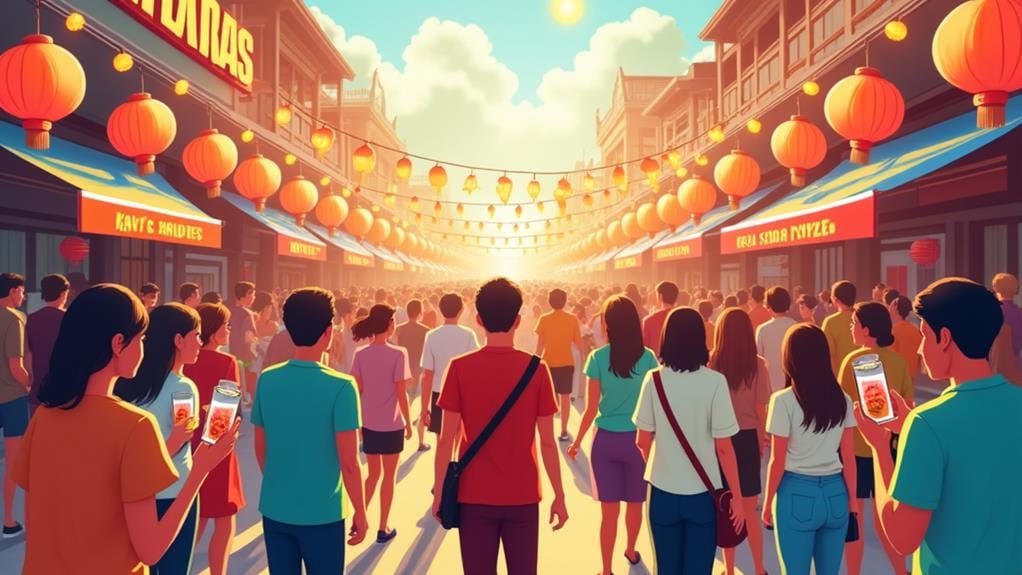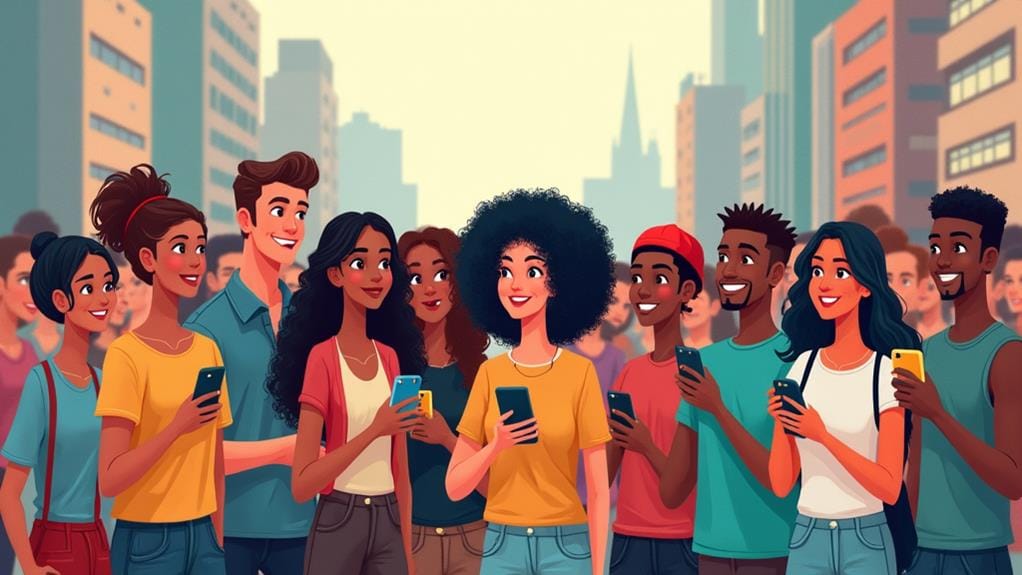

Alors que vous vous efforcez d'entrer en contact avec les consommateurs locaux sur les médias sociaux, il est essentiel de saisir les moteurs psychologiques qui sous-tendent leurs préférences et leurs décisions d'achat. Leur les réactions émotionnelles, normes culturelleset l'identité sociale jouent un rôle important dans leur comportement. En comprenant ces facteurs, vous pouvez adapter votre contenu et vos stratégies de marketing à votre public local. Par exemple, l'utilisation de langue locale et les visuels peuvent favoriser un sentiment d'appartenance à la communauté et stimuler l'engagement. En reconnaissant l'importance de la pertinence culturelle, vous serez mieux équipé pour adapter votre approche et renforcer votre lien avec les consommateurs locaux, ce qui se traduira par des stratégies de médias sociaux plus efficaces.
En explorant le monde de le comportement des consommateurs locaux, médias sociaux apparaît comme une plate-forme essentielle pour comprendre les subtilités de la psychologie des consommateurs locaux.
Vous constatez que le comportement des consommateurs locaux est fortement influencé par normes culturelles et l'identité sociale, 33% des Américains utilisant les médias sociaux pour découvrir de nouveaux produits et de nouvelles marques. En outre, l'efficacité des l'adaptation des produits et de la commercialisation aux préférences locales peut considérablement améliorer l'efficacité de l'action de l'Union européenne. les niveaux d'engagement.
Les réactions émotionnelles jouent un rôle essentiel dans l'élaboration des préférences des consommateurs locaux, car les contenus qui résonnent avec les émotions du public tendent à augmenter l'engagement et le partage.
L'analyse des commentaires et des réactions sur les plateformes de médias sociaux permet de découvrir des informations culturelles et des facteurs émotionnels qui sous-tendent le comportement des consommateurs, améliorant ainsi votre stratégie de communication. stratégies de marque adaptés aux préférences locales.
Vous pouvez acquérir de précieuses client[3] perspectives de engagement en lignece qui vous permet de mieux comprendre la psychologie des consommateurs locaux. En fait, 90% des entreprises ont déclaré que l'engagement en ligne leur avait permis de mieux comprendre les clients.
Vous avez acquis une meilleure compréhension du comportement des consommateurs locaux et de l'importance des médias sociaux dans l'élaboration de leurs préférences.
Il est maintenant temps d'élaborer des stratégies de marketing efficaces qui répondent à leurs motivations et à leurs désirs. La création d'un contenu attrayant est essentielle pour créer un sentiment de communauté sur les plateformes de médias sociaux.
Pour ce faire, comprendre la culture locale est essentielle, car elle permet d'utiliser un argot et des symboles pertinents qui trouvent un écho auprès de votre public.
Pour créer un marketing percutant, envisagez les stratégies suivantes :

Le pouvoir de la événements culturels et les tendances en matière de médias sociaux On ne saurait trop insister sur ce point, en particulier lorsqu'il s'agit des engager les consommateurs locaux. En tirant parti des médias sociaux pour exploiter les événements culturels, vous pouvez avoir un impact profond sur l'expérience du consommateur, en favorisant un sentiment plus profond de connexion et de communauté.
Des événements qui touchent votre public cible, tels que festivals locaux ou les célébrations culturelles, peuvent être mises en évidence pour renforcer l'engagement et montrer l'implication de votre marque dans la communauté. tirer parti des événements locaux.
Lorsque vous créez du contenu qui s'aligne sur les coutumes et les célébrations locales, vous montrez votre engagement à l'égard de l'environnement. sensibilité culturelle, ce qui peut entraîner une augmentation de la fidélité à la marque.
L'utilisation de la langue locale, d'expressions idiomatiques et d'éléments visuels reflétant les points de repère de la communauté crée un sentiment de familiarité, ce qui permet aux consommateurs d'avoir une meilleure résonance émotionnelle avec votre marque.
Comprendre la psychologie du consommateur
L'étude des subtilités de la psychologie du consommateur révèle l'impact profond des normes culturelles et de l'identité sociale sur le comportement des consommateurs locaux. En analysant les interactions sur les médias sociaux, vous découvrirez les strates complexes des décisions d'achat et de la fidélité à la marque au sein de communautés spécifiques.
Pour bien comprendre les consommateurs locaux, il faut saisir les ressorts émotionnels et psychologiques de leurs préférences. Un engagement actif sur les plateformes de médias sociaux peut améliorer la visibilité locale et refléter les valeurs culturelles de la communauté, influençant ainsi les comportements d'achat et les perceptions de la marque.
En outre, L'impact des médias sociaux sur le référencement en augmentant la notoriété de la marque, ce qui est essentiel pour établir un lien avec les publics locaux.
Trois aspects clés de la psychologie du consommateur à examiner :

De nombreuses marques peinent à établir un lien authentique avec les consommateurs locaux sur les médias sociaux, souvent en raison d'un manque de compréhension des valeurs culturelles et des traditions propres à la communauté. Pour relever ce défi, vous devez élaborer des stratégies qui reflètent de manière authentique la culture et les traditions locales, en favorisant la confiance et la crédibilité auprès des consommateurs locaux. Cette approche permet de renforcer les liens émotionnels avec votre marque.
| Stratégie | Résultats |
|---|---|
| Adapter les messages pour intégrer les valeurs culturelles | Un engagement plus fort et des résultats marketing plus percutants |
| Utiliser les médias sociaux pour des conversations à double sens | Renforcement de la fidélité à la marque et de l'engagement communautaire |
| Participer à des événements et à des discussions au sein de la communauté | Engagement manifeste en faveur de la sensibilité culturelle et de l'authenticité |
| Analyser les réactions des médias sociaux | Découvrir les facteurs psychologiques qui sous-tendent le comportement des consommateurs locaux |
| Élaborer un contenu sensible à la culture | Des liens émotionnels plus forts avec les consommateurs locaux |
En établissant une forte présence de la marque de la communauté sur les médias sociaux, vous serez mieux équipé pour établir la confiance et la crédibilité avec les consommateurs locaux. Il s'agit de créer un contenu qui reflète de manière authentique la culture et les traditions locales, en favorisant les liens émotionnels qui stimulent la loyauté et les liens avec la communauté.
S'engager auprès des publics locaux par le biais de contenu spécifique à un lieu peut considérablement améliorer la visibilité et la pertinence de votre marque. En adaptant votre message aux valeurs et aux préférences culturelles, vous ferez participer plus efficacement votre public local, ce qui se traduira par une plus grande fidélité et une meilleure défense de vos intérêts.
Voici trois avantages clés de la création d'une présence communautaire de la marque :

L'évolution constante de la paysage culturel représente un défi pour les marques qui cherchent à rester pertinentes et à se rapprocher des consommateurs locaux.
Pour naviguer sur ce terrain mouvant, vous devrez vous appuyer sur les éléments suivants données sur les médias sociaux pour mieux comprendre le comportement des consommateurs. Cela vous aidera à identifier et à répondre à tendances culturelles émergentes et ses préférences de manière efficace.
Avec 33% des Américains qui utilisent les médias sociaux pour découvrir de nouveaux produits, il est essentiel d'adapter votre message à l'évolution des intérêts culturels.
Pour mesurer le succès et l'impact de vos efforts en matière de médias sociaux, il est essentiel de suivre des indicateurs de performance clés qui vont au-delà des simples mesures de vanité.
Vous devez analyser les réactions des médias sociaux pour mieux comprendre la psychologie des consommateurs locaux et identifier les facteurs émotionnels et psychologiques qui sous-tendent les décisions d'achat.
Pour mesurer efficacement le succès de vos campagnes sur les médias sociaux, concentrez-vous sur les indicateurs suivants :
Vous remarquerez que les médias sociaux influencent le comportement des consommateurs de quatre manières : en instaurant la confiance grâce à la preuve sociale et au marketing personnalisé, en favorisant la fidélité à la marque grâce à la connexion émotionnelle et à l'engagement de la communauté, en tirant parti de l'impact des influenceurs et en incitant à l'achat grâce à des promotions ciblées.
Lorsque vous naviguez sur les médias sociaux, vous êtes animé par un désir de connexion sociale, d'engagement émotionnel et d'expression de votre identité. Vous êtes également influencé par les la peur de manquer[1]Les consommateurs sont de plus en plus nombreux à s'interroger sur la valeur de la marque, à rechercher une validation sociale et à lutter contre la surabondance d'informations, tout en cultivant la fidélité à la marque.
Les décisions d'achat sont influencées par des biais cognitifs, des déclencheurs émotionnels et des preuves sociales. La dynamique de groupe et l'expression de l'identité influencent également vos choix, et conduisent finalement à la prise de décision et à la fidélité à la marque par le biais de forces psychologiques subtiles mais puissantes.
Vous comprenez la psychologie du consommateur en reconnaissant les biais cognitifs et les déclencheurs émotionnels qui conduisent les processus de prise de décision, en analysant comment la perception de la marque est façonnée par les facteurs de confiance, la preuve sociale et les influences culturelles, et en faisant preuve d'empathie à l'égard des besoins et des désirs des consommateurs.